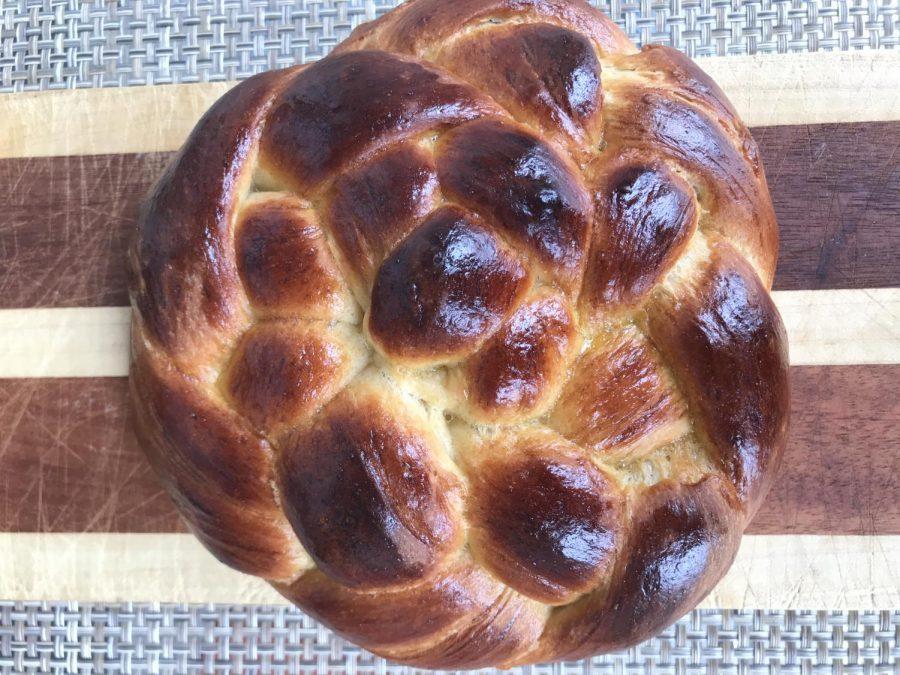Downsized High Holidays menu can be nourishing with a side of symbolism
Published September 22, 2020
When we think about symbolic foods for Jewish holidays, the items on the Passover seder plate immediately come to mind, including the salt water, parsley, matzah and bitter herbs. But rich symbolism also is an ingredient in many of the traditional foods we serve on Rosh Hashanah, the Jewish New Year.
Let’s start with the Rosh Hashanah challah, which, unlike the challahs on Shabbat, at weddings and for other Jewish life cycle occasions, is round.
In “The World of Jewish Cooking,” the beloved late Jewish cookbook author Gil Marks attributes the origin of the round challah to Ukraine and describes its symbolism as follows:
“Traditional Rosh Hashanah forms include rounds (symbolizing continuity, with no beginning and no end), and spirals (symbolizing the King of the Universe).”
We dip apples into honey in hope that the New Year is a sweet one, and we serve carrots (which in Yiddish is meirin meaning “more”) as a symbol of abundance. Pomegranates, which are believed to hold 613 seeds, are symbolic of the 613 commandments in the Torah, each representing a wish for happiness in the New Year. And so on and so on.
This is the year of the COVID-19 Rosh Hashanah, which means that many of us will be eating our holiday meal alone or in small groups. But that downsized feast can still be delicious. And even unique. While you could roast a smaller brisket or chicken and prepare a smaller carrot tzimmes, you might instead consider serving a special one-pot vegetarian stew, the recipe for which I include below.
This special stew is not only scrumptious but rich with symbols of the holiday. To begin with, it is made with seven vegetables. The number 7 relates to the six days of creation and the seventh day of rest. It is served over Israeli couscous. The multitude of those little couscous pearls symbolizes the number of blessings we hope to have over the New Year. My ingredients also include carrots, and they are sliced to resemble gold coins. And, of course, I include honey, for a sweet year.
Best of all, this delicious chickpea (garbanzo bean) stew is hearty and healthy. You cook it entirely on the stovetop and make it a few days in advance. Stored in the refrigerator, you can reheat this stew, spoon it over a fresh pot of couscous and garnish it just before serving. Accompanied by a few slices of your round challah and a salad topped with glistening pomegranate seeds (a Jewish symbol of fertility), this is a holiday dish you may want to make year after year. Best of all, the leftovers taste great even three to four days later.
My other recipe below is for a special holiday cake, a cross between a moist pound cake and an apple pie. That way you can begin your holiday feast with the traditional apple dipped in honey and finish it with apples baked into this yummy cake.
On Rosh Hashanah, which begins this year on the eve of Sept. 18, Tishri 1, we celebrate the beginning of all creation. In Sephardic communities around the world, Jews extend the following greeting to family and friends: Tizku Leshanim Rabot- Ne’imot veTovot. Translation: “May you merit many pleasant and good years.”
During this pandemic, I cannot think of a more meaningful greeting.
Holiday Apple Cake with Cinnamon Sugar Topping
Ingredients
Cake Topping:
- ½c. granulated sugar, divided
- 1½tsp. ground cinnamon
Cake Batter:
- 6oz. (1½sticks) unsalted butter, at
- room temperature
- 1½c. granulated sugar
- 3large eggs, at room temperature
- 1c. plus 1 tbsp. cake flour (or 2 tbsp.
- cornstarch whisked with 1 c. all-
- purpose flour)
- 1 c. plus 1 tbsp. all-purpose flour
- 2 tsp. baking powder
- ½ tsp. coarse kosher salt
- ¾ c. whole milk
- 1½ tsp. finely grated lemon zest
- ¾ tsp. pure vanilla extract
- 3 medium (about 1¼ to 1½ lbs. total)
- Pink Lady or Granny Smith apples, peeled, cored, halved, and cut into
- half-inch slices.
- ¾ c. heavy cream
- Confectioner’s sugar, for dusting top of cake
- Lightly sweetened whipped cream, for serving (optional)
Directions
- Preheat oven to 350 degrees. Butter a 10-inch springform cake pan. Butter pan and line bottom of pan with a round of parchment paper; lightly butter or spray paper.
- To make the topping, stir together granulated sugar and cinnamon in a small bowl; reserve for later to top cake.
- To make the cake batter, beat butter and sugar together in the bowl of a stand mixer fitted with the paddle attachment until mixture is light and fluffy, three to five minutes. Stop the machine twice to scrape down the sides of the bowl.
- Beat in eggs one at a time, making sure each egg is incorporated before adding the next one. Scrape down the bowl between additions.
- In a separate medium bowl, whisk together both flours, baking powder and salt. With mixer on low, add about a third of the flour mixture, followed by half of the milk, then another third of flour mixture, followed by the remaining milk, and finally the remaining flour. Scrape down the bowl as needed between additions. Add lemon zest and vanilla extract and mix on low speed just until incorporated. Mixing the batter too much will result in a tough cake!
- Pour batter into prepared pan and evenly smooth out the batter with a rubber spatula. Arrange apple slices, slightly overlapping, in concentric circles to cover the entire top of the batter.
- Evenly sprinkle top of cake with reserved cinnamon-sugar mixture and drizzle with heavy cream.
- Set cake pan onto a larger foil or parchment paper-lined baking sheet. Place pan onto center rack in preheated oven and bake 45-55 minutes, or until a toothpick inserted in the center of cake comes out clean. Transfer cake pan to a cooling rack. Let cake cool in pan for five minutes and then loosen edges of cake from the sides of the pan with a knife. Open spring and remove outside of pan. Set cake onto a cooling rack; let cool completely.
- Just before serving, work a spatula between cake and parchment. Carefully slide cake onto a serving platter. When completely cooled, lightly dust top of cake with confectioner’s sugar. Slice and serve, with or without a dollop of whipped cream.
Makes 8-10 servings.
Rosh Hashanah Sweet Potato and Chickpea Stew with Israeli Couscous
Ingredients
Beans:
- 1 dried chickpeas (or a 15 oz. can, rinsed and drained; disregard the
- remaining bean ingredients and directions if using canned beans)
- 1½ tsp. baking soda
- 1 bay leaf
- ½ yellow onion, peeled but left attached at the root
- 3 peeled garlic cloves, left whole
- 1 sprig fresh rosemary or thyme, or one of both
- 1 tbsp. olive oil
Stew:
- ¼ c. olive oil
- 3 garlic cloves, peeled and minced
- 1 large yellow onion, peeled and diced
- 2 celery stalks, trimmed and diced
- 1½-2 lbs. sweet potatoes, peeled and cut into 1-inch cubes
- ½ lb. (about 2) parsnips, trimmed, scraped, and cut into 1-inch cubes
- 2 large carrots, trimmed, scraped, and cut into ¼-inch slices
- Reserved bean cooking broth plus enough added vegetable broth to
- equal 7 c. liquid, plus more vegetable
- broth as needed
- ½ tsp. coarse kosher salt, plus more to taste
- 2 tbsp. honey
- 1 tbsp. sweet paprika
- ¼ tsp. freshly ground black pepper, plus more to taste
- ¼ tsp. ground turmeric
- 1 tsp. ground cinnamon
- Pinch of crushed red pepper flakes
- ½ tsp. ground cumin
- ¼ tsp. ground ginger
- 2 tbsp. tomato paste
- 5 oz. fresh baby spinach leaves
- 1 tsp. freshly squeezed lemon juice, or more as needed
Garnish:
- 2 scallions, trimmed and thinly sliced
- 2 tbsp. fresh chopped flat leaf parsley
- 2 tbsp. fresh chopped cilantro
- Israeli Couscous:
- 2 c. pearl (Israeli) couscous (available in bulk at Whole Foods)
- 2 tbsp. olive oil, divided
- 3½ c. boiling water
- ½ tsp. coarse kosher salt
- ¼ tsp. freshly ground black pepper
- 1 tbsp. fresh chopped parsley
- 1 tbsp. fresh chopped cilantro















